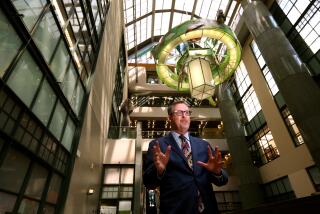Library Amasses Vast Collection on Mary : Archives: University of Dayton has 82,000 books and pamphlets. A surge of Marian enthusiasm is bringing it new popularity.
- Share via
DAYTON, Ohio — The University of Dayton has the distinction of serving as caretaker to the world’s largest collection of books, videos and even some fascinating wine labels related to the life of Mary, “the mother of the whole Christ.”
Housed in the top of the university’s Roesch Library, the Marian Library includes 82,000 books and pamphlets dating from as early as the 15th Century and in more than 50 languages, including Sanskrit, Arabic and Syriac.
There are 4,000 slides of 20th Century art, 8,000 postcards, about 300 statues, 55,000 magazine and newspaper articles, 10,000 postage stamps, as well as paintings, icons and audiocassettes.
The materials are in strong demand these days as apparitions fuel Marian enthusiasm. About 80 apparitions of Mary have been reported over the past 12 years, prompting a separate bibliography and religious educational resources on the topic.
Marian enthusiasts today are beneficiaries of the work of John Elbert, who began the collection 50 years ago while serving as the university’s president. His efforts were a gesture to honor the Society of Mary’s late founder, William Joseph Chaminade, and an acknowledgment of the university’s approaching centennial celebration. He also donated the first book, entitled “Devotion to Mary in the 20th Century.”
“Rather than erect an inert monument, he wished to establish something living and active, a contribution to the mission both of the University of Dayton and the Society of Mary,” said the library’s director, Father Thomas Thompson.
The original mission of the library was not necessarily to collect materials but rather to identify their locations throughout the United States by corresponding with librarians of more than 250 Catholic colleges, Thompson said.
In 1953, however, the library received the remarkable 6,000-volume Leon Clugnet collection, which originated in Europe and dated back to 1860, and its development into an international research library began in earnest.
There are more than 50 books from the 15th Century, most written in German or French. The library also holds an original text of Martin Luther, the founder of Protestantism, who revered the mother of Christ even while rebuking and denouncing the Roman Catholic Church itself.
Several books in the library are manuscripts, produced in the 16th or 17th Century before widespread use of the printing press. Some of these books are highlighted with ornate drawings called illuminations.
Brother Bill Fackovec, who works at the library, said these books typically were produced in rooms without any heat because writers did not want to risk having the manuscripts near fire. “So there in the text they might complain about how cold they were, about how stiff their hands were and how difficult it was to write,” he said.
*
The library receives many rare-book catalogues, usually from dealers in Europe. Fackovec’s job is to study them and determine which books the library may want to acquire.
“Then if the price isn’t too outrageous, and we really want it, I go ahead with the order,” he said.
In addition to its collection of books and items directly related to the life of Mary, the library has many items addressing liturgy, general theology, church history and religious art. The most common portrayal of Mary in the library’s art collection shows her encircling and protecting the Christ child or standing alone in prayer. One series of watercolors depicts Mary’s emotions during her son’s crucifixion. A signed work of Salvador Dali, portraying Christ’s death, hangs in the library.
The library also owns a collection of 10,000 stamps from 180 nations. It is believed to be missing only one stamp involving Mary, an extremely rare Hungarian misprint that has Mary doing a handstand--the result of printing the stamp upside down. Experts believe only four copies exist, each valued at $20,000.
More to Read
Sign up for Essential California
The most important California stories and recommendations in your inbox every morning.
You may occasionally receive promotional content from the Los Angeles Times.









